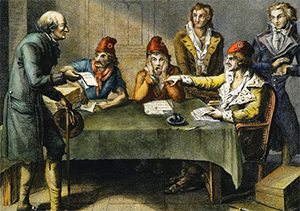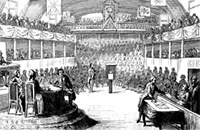The National Convention of France
Part 2: The Revolution Progresses In the early days, the impassioned rhetoric of the Girondins convinced many in the Plain to support a more moderate agenda, and the Girondins had the upper hand over their main rivals, the Montagnards. That changed as time went on. The Girondins, in the spring of 1793, ordered an investigation of the Paris Commune and the arrest of notable The Montagnards had for some time been of similar mind and, indeed, allies with the sans-culottes, members of the Third Estate who regularly pursued a radical agenda that included mob violence. One such episode occurred on June 2, 1793, when the words of the Montagnards and the muscle of the sans-culottes resulted in the expulsion of the Girondins from the Convention. Many Girondins were arrested and declared enemies of the state. Not going away, the Girondins organized from without, finding much sympathy for the federalist cause in the nobles who had not fled the country and others who had been shocked by the execution of their monarch. The Montagnard-run Convention developed a new governmental blueprint, the Constitution of 1793. To defend the new republic, the Convention ordered a draft. In February 1793, the deputies approved a call for 500,000 soldiers to join the revolutionary army. By the end of the year, the army boasted 770,000 men willing to die for the cause of liberty. The result was a compelling series of victories that resulted in a defeat of the Allies in the War of the First Coalition. 
Since its inception, the National Convention had delegated most of the detailed work to its various committees. In 1793, the Convention designated the Committee of Public Safety as the supreme executive authority. Chief among the members of that committee was Robespierre, who presided over a large number of trials and executions of those suspected of treason. For many months, France suffered through the Reign of Terror, when the guillotine ended the life of thousands of "enemies of the state." At the same time, the Convention embarked on campaigns of terror outside Paris. In one instance, targeting Girondists who had coalesced in the city of Lyons, the Montagnard-dominated Convention ordered the destruction of the homes of and buildings inhabited by nobles in that city and its name changed to the Liberated City. Arrests and executions numbered more than 3,000. The Reign of Terror eventually came to an end, as its leaders themselves, Robespierre among them, were executed. In 1794, the Girondins took back control of the government, in a series of events known as the Thermidorian Reaction. All Jacobin Clubs were closed. The country had yet another constitution, which established a new legislative body, a bicameral parliament known as the Directory. On Nov. 3, 1795, this entity took over, ending the National Convention. Among the often overlooked achievements of the National Convention were these:
The Convention encouraged the pursuit of higher education and scientific study, creating a Museum of Natural History, a National Conservatory of Arts and Industries, and a National Institute (to replace abolished academies and universities). First page > Earlier Legislative Bodies > Page 1, 2 |
|
Social Studies for Kids
copyright 2002–2026
David White



 Montagnard journalist
Montagnard journalist  granting women the right to own property
granting women the right to own property
